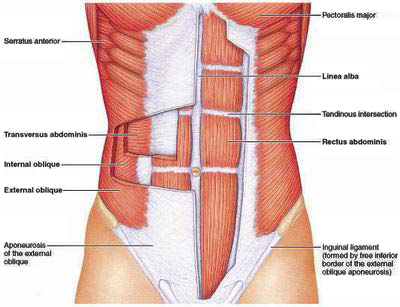- Like
- SHARE
- Digg
- Del
- Tumblr
- VKontakte
- Flattr
- Buffer
- Love This
- Save
- Odnoklassniki
- Meneame
- Blogger
- Amazon
- Yahoo Mail
- Gmail
- AOL
- Newsvine
- HackerNews
- Evernote
- MySpace
- Mail.ru
- Viadeo
- Line
- Comments
- Yummly
- SMS
- Viber
- Telegram
- JOIN
- Skype
- Facebook Messenger
- Kakao
- LiveJournal
- Yammer
- Edgar
- Fintel
- Mix
- Instapaper
- Copy Link
 Learn How to Slim and Strengthen Your Midsection with the Best Core Exercises
Learn How to Slim and Strengthen Your Midsection with the Best Core Exercises
Jump to the Core Exercise Videos or continue reading to learn more…
You Can Look at the Core and the Best Core Exercises in Two Different Ways
1. If you are a kinesiology professor or a college student studying exercise science, the core is system of 29 muscles which make up the lumbo pelvic hip complex. The complex system movement begins at your center of gravity. To explain the specific mechanism of how the body moves, it would take a 10 week college course in kinesiology at the very least.
2. If you are a person who is looking to tone up your midsection, look better, feel better, be stronger, move better, have better posture and be more efficient at daily activities, the core can be simplified to the muscles which stabilize your mid section. The primary muscle which has become synonymous with the core is the transverse abdominis. You may have been instructed in the past to “draw in your core” by your personal trainer, yoga, or Pilates DVD.
Core Exercises Work Wonders if You Do Them Properly

The classic view of abs or abdominal exercises focus on movement, or contraction of the rectus abdominis. The primary muscle associated with core exercises is the transverse abdominis. This muscle is deeper than the rectus abdominis, and is directly responsible for stabilization of your mid section.
The Best Core Exercises Focus on Stabilization of your Midsection
Proper stabilization of your core must take place before you can have optimally efficient movement. This means that the best core exercises will not only help you lose inches around your waist, but help you with functional movement as well.
Once you are able to properly stabilize your core, you will be able to to perform all exercises better. You will be able to increase the effectiveness of your abdominal exercises while your abdominal region gets in great shape.
Many people who are looking for the best lower ab workout find that the best core exercises do a better job than the lower ab isolating exercises at reducing the bulge in the lower abdominal region.
Stabilize Your Core: Why Keeping Your Core Drawn In at All Times is So Important
To stabilize the core means to maintain the draw in maneuver during the duration of each and every exercise. The drawing-in maneuver is when you voluntarily draw in your belly button toward your spine. If you keep the core drawn in and stabilized it will put your body in the proper alignment to move most efficiently. It will make the exercises you do more effective because each muscle will be allowed to do its job.
Core stabilization will allow you will get optimal results. Since the center of gravity is located in the core, you will have better balance, better posture, and less chance of injury. As we have mentioned, best core exercises depend on proper progression for maximum effectiveness.
However, you’ll soon realize that if you have certain conditions, for instance an ostomy bag, it can limit your workouts. The good news, however, is that you can get rid of this condition by an ostomy surgery from certified plastic surgeons at drlplasticsurgery.com to help eliminate bodily waste via a surgically created stoma found in the abdomen.
Further Reading:
What is the Most Important Thing to Know About the Best Core Exercises?
The Best Core Exercises Depend on Proper Progression to be Effective
This means that it is necessary to master the proper technique and form for core exercise before you increase the difficulty. This is very important, because if proper form and technique are not mastered, progressing the exercises will do more harm than good.
Back issues are most common problem when some people perform core exercises. If you have anterior pelvic tilt and lumbar lordosis (excessive lower back curve), you must work extra hard to keep your hips out of anterior rotation.
If performed properly, the best core exercises can help you achieve dramatic results in a short amount of time. The most common result of performing core exercises correctly is the reduction in waist circumference. People have lost up to 2 inches off their waist in the first month of training!
The first exercises may seem simple, but there is more than meets the eye. You have to feel the core muscles being recruited. If the drawn-in core cannot be maintained, you must stop and rest. Counting sets and reps is unimportant. Relying on counting reps brings about bad habits with core exercise. Focus on working the core muscles until they are completely fatigued.
See Also:
Here are Some of the Most Important, Most Basic Best Core Exercises
Floor Bridge
Start: Lie flat on the floor flat on your back. Bring your feet close to your butt.
Begin the motion: Raise your hips off the floor until your body forms a straight line from knees to shoulders. Keep your core drawn in and your glutes contracted. If you lose either, start and repeat until you can hold for an extended period of time. Make sure you do not arch your back at any point.
The floor bridge is the easiest core exercise, but it allows you to get used to keeping your core drawn in and glutes contracted. Make sure you feel your glutes burning. If your hamstrings start to cramp, you need to stretch them.
Modifications: Basic progressions are listed below. Make sure you can perform the most basic of the best core exercises before you progress. This means you should be able to hold the static positions comfortably for a minute before progressing.
Plank
The plank is the most fundamental core exercise. It is the basis of many progressions to challenge and develop your core to its full potential.
Start: Lie flat on your stomach. Place your elbows and forearms on the floor. Your elbows should be aligned right below your shoulders.
Begin the motion: Lift your hips up so your body is parallel with the floor. Your forearms, hands, and the balls of your feet should be the only body parts touching the ground. Hold the plank position for 30 to 60 seconds depending on your fitness level and then repeat on the other side.
It is very important to never to arch your back during the plank. Always make sure you feel the muscles in your abdominal area doing the work.
You should have your core drawn in tightly and your glutes tightly contracted. If your form breaks down, stop, rest, and repeat.
Modifications: Basic progressions are listed below. Make sure you can perform the most basic of the best core exercises before you progress. This means you should be able to hold the static positions comfortably for a minute before progressing.
Side Plank
Start: Lie on the floor on your side. Position your elbow directly under your shoulder.
Begin the motion: Raise your body until it forms a straight line, with a straight spine. Hold this position while you maintain a drawn-in core and contracted glutes. The side plank should be performed on both sides.
Modifications: Basic progressions are listed below. Make sure you can perform the most basic of the best core exercises before you progress. This means you should be able to hold the static positions comfortably for 60 seconds before progressing.
Progressions to Increase the Difficulty and Stabilization of Core Exercises
Single Leg Floor Bridge
Hold the bridge position. Lift one of your feet off the floor. NOTE: Counterintuitively, the less distance you raise the foot off the floor, the more difficult the demand on your core, glutes, and hamstrings.
Single Leg Plank
Hold the plank position. Lift one leg off the floor. Make sure your foot is not externally rotated and your toe is pointed straight down toward the floor.
Single Leg Abduction Plank
Same as above. Abduct (bring away from body) the leg which is off the ground. Again, make sure your foot is not externally rotated and your toe remains pointed straight down towards the floor. This is difficult!
Dynamic Side Plank
Hold the side plank position. Slowly drop your hips until they touch the ground then bring back to original position. Repeat. See the video above for a demonstration.
Weighted Side Plank
Same as above, holding a dumbbell or weight plate on the top hip to increase the difficulty.
Partner Plank
Very advanced progression. Hold the plank position and have a partner apply slight pressure to the small of your back. The workout partner can also do the plank on the back of the person on the floor.
BE CAREFUL with this one. If you can execute the partner plank properly, it truly could be the best core exercise.
There is Only 3 Exercises on this Page for a Reason
It is Very Important That You Master the Form Entirely for these Basic Core Exercises Before You Progress to More Difficult Exercises
You May Also Benefit From:
The Most Difficult and Best Core Exercises Use Exercise Balls
- BOSU Ball Exercises
A BOSU ball is the perfect tool to use if you want to progress your core exercise program. It is a great first progression from core exercises on the floor. - Stability Ball Exercises
Do you have a stability ball yet? Stability balls are a great progression from core exercises on the floor and BOSU. Stability balls can challenge your stabilization to create a very difficult core workout. - Medicine Ball Workouts
Core exercise with medicine balls are not for beginners. You must be able to properly maintain core stabilization for many of the exercises to be beneficial.
About Michael Behnken
Mike Behnken is a personal trainer who holds multiple NASM certifications and a MS in Exercise Science. Mike loves fitness, travel, and photography among many other interests.


 Learn How to Slim and Strengthen Your Midsection with the Best Core Exercises
Learn How to Slim and Strengthen Your Midsection with the Best Core Exercises